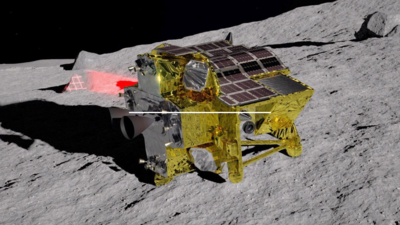- News
- World News
- Rest of World News
- Japan's 'Moon Sniper' makes historic lunar landing but suffers slight hiccup
Trending
This story is from January 19, 2024
Japan's 'Moon Sniper' makes historic lunar landing but suffers slight hiccup
Japan's Smart Lander for Investigating Moon (Slim) probe, also known as the Moon Sniper, successfully landed on the Moon's surface using pinpoint technology. The spacecraft, developed by Japan Aerospace Exploration Agency (Jaxa), encountered a slight hiccup as it landed on a slope of a crater and is currently relying on its battery for power.
NEW DELHI: Japan made history on Friday by becoming only the fifth nation to land a spacecraft on the Moon, albeit with a slight hiccup.
Japan Aerospace Exploration Agency's Smart Lander for Investigating Moon (Slim) probe, dubbed the "Moon Sniper", is thought to have landed on the slope of a crater just south of the lunar equator using "pinpoint technology".
The exact location of the probe might take a month to determine, said officials.
Solar panels not generating power
Asked by a reporter if the soft landing was "successful" or a "failure", Jaxa chief Hitoshi Kuninaka replied: "We believe the soft landing itself was successful as the spacecraft sent telemetry date, meaning most equipment on board was operating."
The spacecraft also took photos of the Moon’s surface before landing, officials said, adding that some systems have been shutdown to ensure that the craft is able to transmit the data back to Earth before the battery runs out.
Kuninaka added that the solar generation problem might be due to the fact that the craft, which landed on a slope of a crater, might be at an unintended angle.
Pinpoint technology
The pinpoint technology has been previously used by Japan to successfully land probes on two asteroids.
The craft's landing site was an area within 100 metres (330 feet) of a spot on the surface, far tighter than the usual landing zone of several kilometres.
JAXA stresses its high-precision technology will become a powerful tool in future exploration of hilly Moon poles, seen as a potential source of oxygen, fuel and water.
The somewhat successful Moon landing reverses Japan's fortunes in space after two failed lunar missions and recent rocket failures, including explosions after take-off.
Two probes
Slim also deployed two mini-probes - a hopping vehicle as big as a microwave oven and a baseball-sized wheeled rover - that will take pictures of the spacecraft.
Tech giant Sony Group, toymaker Tomy and several Japanese universities jointly developed the robots.
Japan is increasingly looking to play a bigger role in space, partnering with close ally Washington to respond to China's military and technological might, including in space. Japan boasts a number of private-sector space startups and aims to send an astronaut to the Moon as part of Nasa's Artemis programme.
In August last year, India's Chandrayaan-3 made a historic touchdown on the Moon's south pole, a major technological feat given the rough terrain, highlighting India's rise as a major player in space.
Japan is also planning a joint unmanned lunar polar exploration with India in 2025.
(With inputs from agencies)
End of Article
FOLLOW US ON SOCIAL MEDIA











